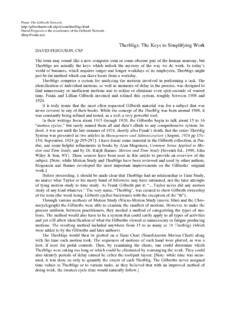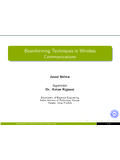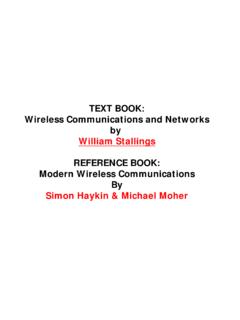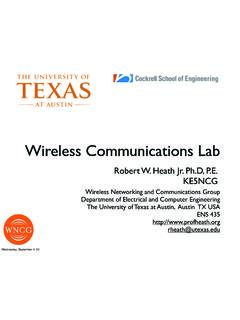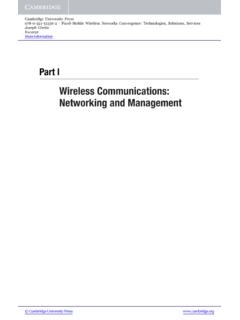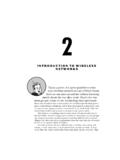Transcription of Wireless Communications and Networks
1 1 MITW ireless Communications and NetworksMuriel Medard2 MITWhen do we use codes Two different types of codes: source codes: compression channel codes: error-correction Source-channel separation theorem says the two can bedone independently for a large family of channelsSourceencoderChannelencoderChann el decoderstreamModulator, channel, receiver, The physical layer Wireless telephony: FDMA TDMA CDMA UWB 3G Wireless networking: Bluetooth Ad hoc networks4 MITP hysical layer The physical layer plays a very important role in wirelessnetwork because it has severe limitation on transmissionsUplink with respect to downlink is more restricted:-more multiple access interference-more restrictions on power because of battery use and because or user safety-more decentralized problem uplinkdownlinkBase station5 MITThe cellular systemThe area of coverage ofDifferent base stations islogically a tessellation ofthe spaceWhen a user is better servedBy a different base station,hand-off occursIn reality, cell coverage is extremely uneven and irregular:There are dead spots and areasof overlapHandoffInter-cellinterferenceIntr a-cellinterference6 MITA ntennas Base stations are generally antennas on towers or on top ofbuildings, with heavy tendency towards co-location, as thereal estate is generally owned by a few companies Antennas can have directionality, giving sectors of the cells Sectors reduce interference, but also pose coverage issuesAntenna lobes7 MITUse of multiple antennas Multiple antennas can be used in two ways.
2 In an adaptive fashion to cancel out interference In a static fashion to gather more of the signal: optimalways of combining the outputs rely on maximumlikelihood detection8 MITMIMO systems High SNR case: capacity goes with log(SNR) and min oftransmit and receive antennas Use of space-time-codes, Alamouti schemes Very sensitive to changes in channel and uncertainty inreceive channel Low SNR case: antennas just help to gather energy, capacitydepends only SNR and number of receive antennas\ Use of impulsive transmission schemes to achieve capacity ornear capacity9 MITW ireless Channel ModelReal partof impulseresponseTime10 MITW ireless Channel ModelReal partof impulseresponseTime11 MITW ireless Channel ModelReal partof impulseresponseTime12 MITTime SpreadDoppler shiftWireless Channel ModelReal partof impulseresponseTime13 MITV ariations in time and frequency The channel roughly changes across time and frequency In time, the time for change is roughly given by Tc, thecoherence time The coherence time is generally taken to be the inverse of theDoppler spread, which is proportional to the speed of themobile with respect to the obstacle and to the carrier frequency In frequency, the bandwidth for change is roughly given by Fc.
3 The coherence bandwidth The coherence bandwidth is generally taken to the inverse ofthe time spread Most of the channels for Wireless applications are of theunderspread type, which means that TcFc >> 114 MITI mplications of variations Variations occur and lead to fades It is difficult to transmit during fades in time or in frequency Therefore we try to achieve diversity in time and infrequency Diversity in frequency may be difficult to achieve because ofregulatory issues around spectrum Diversity in time can be achieved but at the expense of delay use of interleaving to make the channel look memorylessa b c d e fa b c d e f a a b b c c d d interleavinggoodbadgood15 MITHow to adapt to the fades Slow fades: due to terrain, shadowing, weather, foliage Fast fades: due to short term multipath variations What can we adapt for and what should we adapt for? Limitation: finite battery energy and power safety constraints Two ways of adapting: Open loop: mobile detects a pilot symbol or pilot tone anduses that knowledge to adapt Closed loop: base station specifically sends controlsignals to the mobile, the mobile adapts and the basestation detects the adaptationInformationInformation16 MITA daptation and multiple access The near-far effect: In the case of open loop control, a mobile cannot make up formultiple access effects such as the near-far effect In the case of closed loop control, the users that are far canincrease their power, while the users that are far away candecrease their power Can we use power control to make up for fast fades?
4 Tc isabout 1/100 s, so would easily require 1000 bits/sThe car closest to the base station overpowers the other car17 MITR eceivers The receiver must take into account the instantaneous effect of thechannel Rake receiver is a means of taking into account the maincomponents of the channel Channel tap: sample of the channel The Rake receiver finds the main non-zero taps (fingers) Note: phase is needed to get information beyond the amplitudeChannel descriptionRake receiverEstimation/detection18 MITHow to perform multiple accessUser 3 User 2 TimeFrequencyUser 1 TimeFrequencyUser 3 User 2 User 1 FDMATDMAF requencyTimeFrequencyHoppingSpreadspectr umMixture of all colorsTimeFrequencyDirect SequenceSpreadspectrum19 MITC hannels in FDMA Channels in each cell Each user in a cell is given an uplink channel and a downlink channel AMPS: 30 kHz wide 1993 old AMPS and NAMPS => IS-91 Uplink Dowlink A channels (channels 1-> 333) competitive provider B channels (channels 334 ->666) -> wireline carrierA A B A B MHzA A B A B MHz20 MITM anaging channels in cells Certain cells may have heavier requirements than others at different times Standard fixed channel assignment: a channel is used every 7 cells Other idea is to borrowchannels from cells thatare less used Alternatively, someChannels may be permanently assignedto certain base stationswhile others are in ashared poolAlternatively make cells smallery cell-splitting down to + + + + + + + +3n+ European GSM (groupe special mobile), IS-54 (US standard), JDC(Japan) GSM standardization effort started in 1987, Phase 2 ended in 1995 Divide a little in frequency, a lot in time GSM.
5 Eight channels per carrier with a gross data rate of kbps (bitrate of 13 kbps) Frame is ms and time slots are ms for transmissionand reception 200 kHz channel spacing Gaussian minimum shift keying (GMSK)22 MITTDMAPre-ambleSlot 1 Slot 2 Slot 2 Slot nPre-ambleSlot 1 One framePre=ambleUser 1 User pGuard time23 MITTDMA IS-54 keeps the 30 kHz spacing of AMPS Each frequency can give kbps Uses /4-differential quadrature phase shift keying at Frame duration is 40 ms 6 time slots per frame Each time slot carries 260 bits of user information Total 395 30 kHz voice channels Total MHz system bandwidth24 MITCDMA Code division multiple access Roots are in military applications: Anti-jam Low-probability of intercept Frequency hop: Slow: hop every few bits Fast: hop every bit or faster Relatively expensive because of tuning Direct sequence: Use a spreading sequence to allow al users to share thebandwidth at all times25 MITDS-CDMAData timeW/2-W/2Ws/2-Ws/2spreadingtimeSpreadi ng sequence:chipsWs > WSpreading gain = chip rate/data rate26 MITIS-95 Chip rate Mcps Modulation is QPSK on forward.
6 OQPSK on rverse Filtered bandwidth in uplink or downlink is MHz 63 Walsh codes per link for forward Convolutional coding with Viterbi decoding Interleaving with 20 ms span Main mode is 9600 bps (also available as 14,400 bps) Available in the 90 MHz range and the PCS 2 GHz range Reverse and forward links are separated by 45 MHz in theformer and 80 MHz in the latter27 MITCDMA2000 3-G system, generated in accordance with the recommendations ofthe International Mobile Telecommunications (IMT)-2000 of theITU (International Telecommunications Union) Main features: Channel sizes of 1,3 , 6, 9 and 12 MHz Advanced antenna technology support Greater possible cell sites, up to megacells (>35 km in radius),down to picocells (<50m) Allows voice services End-user data services, packet data service node (PDSN) tosupport Intenet/intranet data connectivity Corresponding Universal Wireless Communications (UWC) is IS-13628 MITT hird generation Loose partnership for standardization is the Third Generation PartnershipProject (3 GPP) Predominantly Wideband-CDMA (W-CDMA) DOCOMO W-CDMA, UTRA (W-CDMA and T-CDMA) (UMTS terrestrial radio access) (UMTS= Universal mobile telecommunicationssystem), EDGE (enhanced data rates for GSM evolution), IS-136 (digitalAMPS, yielding up to 2 Mbps using TDMA technology close to EDGE) Mcps for DOCOMO, for UMTS UTRA not synchronized base station Frame lengths: 10 ms for both For comparison CDMA200.
7 Mcps Synchronized base station 20 ms frame length29 MITNew services to core network connectionEvolved GSM coreGPRS IPcoreIS-41 WCDMATD-CDMAEDGECDMA2000 GPRS: GSM General Packet Radio Service EDGE: Enhanced Data Rates for GSM EvolutionIS-41: industry standard for inter-switch signaling that allows validation of Wireless calls and call completion in out-of-area markets30 MITP erformance comparison Garg and Wilkes: ratio of number of mobile users Viterbi: Erlang capacity with imperfect power control (3-sector per station), CDMA has a factor 6 improvement How to reconcile the different numbers? Becomes very implementation specific and highly reliant onthe channel accessR1R2 Points are achievedby performing successive cancellation:considering one user as noise to the otherThe Cover-Wyner rate regionInterference region : rate is given entirely by SIRtraditional approach of cellularwireless CDMAA chievable by TDMA or FDMA (includes OFDMA)32 MITHigh SNR CaseIn the case of high SNR, system is quasi-optimal if runas a TDMA systemR1R2 TDMA curve closely approximates maximum sum rateInterference region is very suboptimal33 MITLow SNR case - InterferenceR1R2 Corner of interference region is close to maximum sum rateBase station The users compete for SIR atthe base station The traditional cellularapproach is a max-minapproach based on explicitcommands using closed-loopcontrol No concept of priority.
8 Whether permanent or inresponse to a rapid change ofcircumstances34 MITI ntermediate SNRs Neither TDM nor SIR-based CDMA systems are close tooptimalR1R2 The decoding order changes the rateat the receiverwithout requiring a change of powerIn effect obviates the near-far problem by making use of SIR differences to decode stronger user first and removeits interference to the other users All rates on the maximum sum rate are achievable using rate-splitting35 MITO verview of UWB Wireless Communications over broad band have beenevolving rapidly Quest: uncoordinated, cheap access to large amounts ofbandwidth for many users What do theoretical limits tell us about how possible this is? Topics: Effectiveness of different spreading techniques - CDMA,FH, PPM, flash signaling When happens when we are not bandwidth limited? Can we find simple schemes that successfullyapproximate the infinite bandwidth results? Can we have uncoordinated multiple access?36 MITS preading DS-CDMA (direct sequence code division multiple access)has gained considerable commercial importance Spread in frequency by transforming bits into a series of chips Every user appears as noise to all other users, good LPI Why not simply extend this to higher bandwidths?
9 Does not scale when channel decorrelates in time andfrequency (Medard and Gallager, 1997, 2002, Telatar and Tse1999, Hajek and Subramanian, 1999, 2002) Intuitive justification - cannot track the channel well enough tomake reliable decisions because there is not enough energy inany portion of the spectrum37 MITP ulse-position modulation (PPM) Spread-spectrum multiple-access Wireless system Time-hopping baseband signal comprised of very short pulses -occupies frequency band from near-DC to several GHz, Low power-spectral density Interference to other narrow-band systems should be low(although very poor from the point of view of peak interference) Appears to be sub-optimal from the point of view ofapproaching capacity - it is limited theoretically by the timespread, so may not be useful for very wide bands Not very LPI38 MITF requency hopping Robust to fades by changing frequencies Does not suffer from channel tracking issues of DS-CDMA because there is enough energy transmitted in a single portionof the spectrum to identify the channel Not generally used in commercial systems, except as someextra diversity added onto other systems Somewhat LPI39 MITWhat if we had unlimited bandwidth?
10 Capacity of infinite-bandwidth multipath fading channel isequal to the capacity of the infinite-bandwidth channel withnoise only Capacity can be achieved using frequency-shift keying withnon-coherent detection by transmitting at a low duty cycle -``peaky'' or flash signaling (looks similar to FH) How does the probability of error decay to zero as bandwidthapproaches infinity for rates under capacity? Very slowly if we want to approach capacity (bandwidthmust grow rapidly to achieve low probability of error if weare close to capacity) Other drawback- huge peak energy40 MITCan we approach the infinite bandwidth limitwith finite bandwidth? Use FSK that is somewhat impulsive and also use it over morethan a single tone at a time Code over the tones that are used, rather than a single tone - thusallowing a reduction in peak energy Gets close to capacity for large bandwidths where DS-CDMA orPPM may no longer be effective Gracefully goes from energy-limited to bandwidth-limited regime Joint work with Cheng Luo and Lizhong Zheng41 MITC apacity vs.









